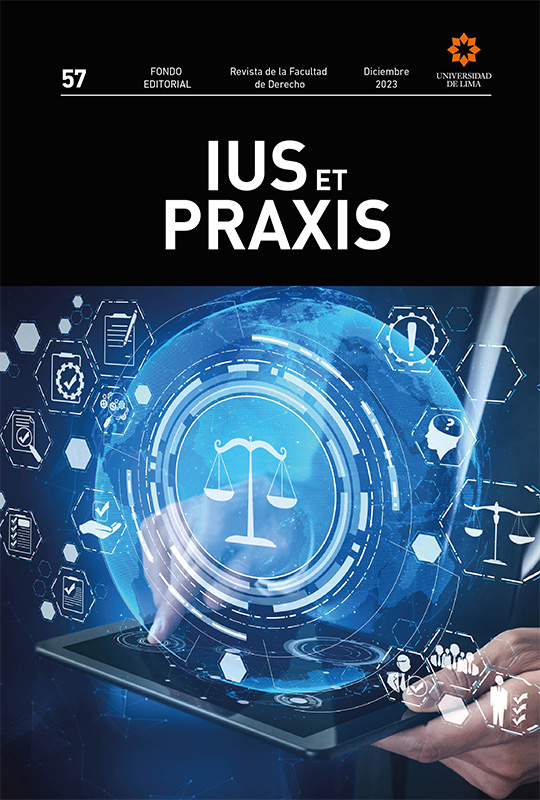The road to modernisation of the judiciary through digitisation and the use of information and communication technologies
DOI:
https://doi.org/10.26439/iusetpraxis2023.n057.6695Keywords:
judiciary, judicial process, procedural overload, duration of processes, interoperability, transparency, predictability, digitalization, information and communication technologies (ICT).Abstract
The main function of the Judiciary is to resolve the various conflicts of interest and legal uncertainties that arise in the society in order to achieve the desired social peace. However, the administration of justice in our country is far from being considered efficient, timely and effective. In this article we expose the deficiencies that afflict the Peruvian Judicial System and how the digitalization and development of Information and Communication Technologies (ICTs) in different latitudes, and specifically in Peru, provide us with the necessary tools to move towards the expected modernization of the administration of justice, and thus be able to aspire to have a celere, efficient, effective, transparent and predictable Judiciary.
Downloads
References
Aspis, A. (2010). Las TIC y el rol de la justicia en Latinoamérica. Derecho & Sociedad, (35), 327-340. https://revistas.pucp.edu.pe/index.php/derechoysociedad/article/view/13311
Comisión de Integridad Judicial. (2022, 5 de enero). Discurso de apertura del año judicial 2022 parte 3 [Video]. YouTube. https://www.youtube.com/watch?v=OdHDaEhTn6o
Concepto. (2021). Ofimática. https://concepto.de/ofimatica/
Cordella, A., & Continio, F. (2020). Tecnologías digitales para mejorar los sistemas de justicia. Un conjunto de herramientas para la acción. Banco Interamericano de Desarrollo. https://publications.iadb.org/publications/spanish/document/Tecnologias-digitales-para-mejorar-los-sistemas-de-justicia-un-conjunto-deherramientas-para-la-accion.pdf
Decreto Supremo 12-2021-JUS. Por medio del cual se aprueba la Política Pública de Reforma del Sistema de Justicia. 15 de julio del 2021. https://www.gob.pe/institucion/minjus/normas-legales/2021726-012-2021-jus
Estevez, E., Linares Lejarraga, S., & Fillottrani, P. (2020). Prometea. Transformando la administración de justicia con herramientas de inteligencia artificial. Banco Interamericano de Desarrollo. https://publications.iadb.org/publications/spanish/document/PROMETEA-Transformando-la-administracion-de-justiciacon-herramientas-de-inteligencia-artificial.pdf
Florez, O. (2011). Uso de las tecnologías de la información y las comunicaciones (TIC) en los sistemas judiciales. Sistemas Judiciales, 9(16), 56-63. https://sistemasjudiciales.org/wp-content/uploads/2018/04/revista16_completa.pdf
Martínez, G. (2012). La inteligencia artificial y su aplicación al campo del derecho. Alegatos (82), 827-846. https://www.corteidh.or.cr/tablas/r30570.pdf
Otero, C. (2022, 19 de marzo). China utiliza jueces robot para dictar sentencias en varios tipos de delitos menores. Meristation. https://as.com/meristation/2022/03/19/betech/1647672219_333452.html
PayPal. (2023). ¿Cuál es la diferencia entre una disputa y una reclamación? https://www.paypal.com/es/cshelp/article/%C2%BFcu%C3%A1l-es-la-diferencia-entreuna-disputa-y-una-reclamaci%C3%B3n-help238
Poder Judicial del Perú. (2020). Plan Estratégico Institucional del Poder Judicial 2020-2030. Comisión de Seguimiento y Ejecución del Plan Estratégico Institucional. https://www.pj.gob.pe/wps/wcm/connect/9768f78048fcb5a1a112f59026c349a4/Plan+Estratgico+Institucional+del+Poder+Judicial+20212030_compressed.pdf?MOD=AJPERES&CACHEID=9768f78048fcb5a1a112f59026c349a4
Secretaría Técnica de la Comisión de Trabajo del Expediente Judicial Electrónico del Poder Judicial. (2021). El Expediente Judicial Electrónico. Poder Judicial del Perú, Fondo Editorial. https://eje.pe/wps/wcm/connect/56bc650042b185bebcd7bc5aa55ef1d3/Expediente%2BJudicial%2BElectr%C3%B3nico_EJE_Web.pdf?MOD=AJPERES&CACHEID=56bc650042b185bebcd7bc5aa55ef1d3
Steelman, D., Goerdt, J., & McMillan, J. (2000). Caseflow management. The heart of court management in the new millennium [Gestión del flujo de casos. El corazón de la administración de la corte en el nuevo milenio]. National Center for State Courts. https://ncsc.contentdm.oclc.org/digital/collection/ctadmin/id/1498
Tribunal Constitucional. (2023, 17 de agosto). Tribunal Constitucional y Poder Judicial firman convenio de interoperabilidad de expedientes y metadatos digitalizados. https://www.tc.gob.pe/institucional/notas-de-prensa/tribunal-constitucional-y-poderjudicial-firman-convenio-de-interoperabilidad-de-expedientes-y-metadatosdigitalizados/


